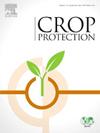氯氟氰菊酯对普通切割虫(鳞翅目:夜蛾科)的抗药性风险评估和适应成本
IF 2.5
2区 农林科学
Q1 AGRONOMY
引用次数: 0
摘要
作为一种主要的农作物害虫,普通切割虫(CCW)Spodoptera litura(Fabricius)已经对多种杀虫剂产生了抗药性。环丙氟苯胺是一种新型元二胺杀虫剂,靶向γ-氨基丁酸受体(GABAR),对鳞翅目害虫(包括CCW)具有极佳的杀虫活性。因此,对 CCW 对环丙氟苯胺的抗性风险进行了评估,并对其适应性成本进行了评估。在接触环丙氟苯胺 10 代(F10)后,CCW 对环丙氟苯胺的半致死浓度值增加了 1.26 倍。假定田间对环丙氟苯胺的遗传率(h2)为实验室估计值(h2 = 0.09),且 CCW 的死亡率为 50-90%,则需要 126-57 代才能获得对环丙氟苯胺 10 倍的抗性。经氟虫腈筛选10代后,卵期、幼虫期、蛹前期和雌蛹重显著增加,但蛹期、化蛹率和生命周期率显著下降。F10的平均世代时间(T)明显延长了4.39天。F10 的相对适合度(Rf)值为 0.99。虽然抗性发展缓慢,但卵期和幼虫期的延长对田间管理 CCW 有一定影响。这些信息将有助于确定延缓CCW对氰虫酰胺产生抗性的方法。本文章由计算机程序翻译,如有差异,请以英文原文为准。
Resistance risk assessment and fitness cost of cyproflanilide in the common cutworm, Spodoptera litura (Lepidoptera: Noctuidae)
As a major crop pest, common cutworm (CCW) Spodoptera litura (Fabricius) has evolved resistance to several insecticides. Cyproflanilide is a novel meta -diamide insecticide targeting the γ-aminobutyric acid receptor (GABAR), and displays excellent insecticidal activity against lepidopteran pests, including CCW. Therefore, the resistance risk of CCW against cyproflanilide was assessed and the fitness cost was evaluated as well. After exposure with cyproflanilide for 10 generations (F10), the LC50 values of CCW against cyproflanilide increased 1.26 - fold. When the realized heritability (h 2 h 2 T ) of F10 was significantly prolonged by 4.39 days. The value of relative fitness (R f
求助全文
通过发布文献求助,成功后即可免费获取论文全文。
去求助
来源期刊

Crop Protection
农林科学-农艺学
CiteScore
6.10
自引率
3.60%
发文量
200
审稿时长
29 days
期刊介绍:
The Editors of Crop Protection especially welcome papers describing an interdisciplinary approach showing how different control strategies can be integrated into practical pest management programs, covering high and low input agricultural systems worldwide. Crop Protection particularly emphasizes the practical aspects of control in the field and for protected crops, and includes work which may lead in the near future to more effective control. The journal does not duplicate the many existing excellent biological science journals, which deal mainly with the more fundamental aspects of plant pathology, applied zoology and weed science. Crop Protection covers all practical aspects of pest, disease and weed control, including the following topics:
-Abiotic damage-
Agronomic control methods-
Assessment of pest and disease damage-
Molecular methods for the detection and assessment of pests and diseases-
Biological control-
Biorational pesticides-
Control of animal pests of world crops-
Control of diseases of crop plants caused by microorganisms-
Control of weeds and integrated management-
Economic considerations-
Effects of plant growth regulators-
Environmental benefits of reduced pesticide use-
Environmental effects of pesticides-
Epidemiology of pests and diseases in relation to control-
GM Crops, and genetic engineering applications-
Importance and control of postharvest crop losses-
Integrated control-
Interrelationships and compatibility among different control strategies-
Invasive species as they relate to implications for crop protection-
Pesticide application methods-
Pest management-
Phytobiomes for pest and disease control-
Resistance management-
Sampling and monitoring schemes for diseases, nematodes, pests and weeds.
 求助内容:
求助内容: 应助结果提醒方式:
应助结果提醒方式:


